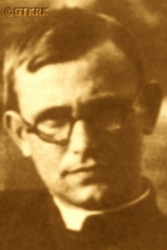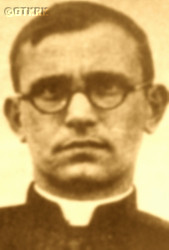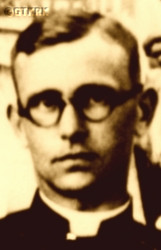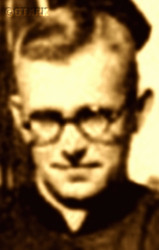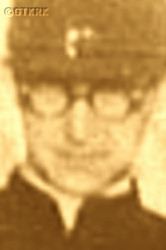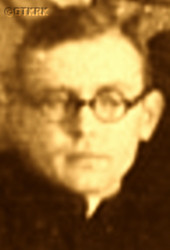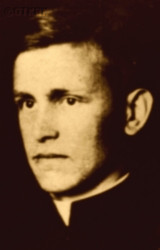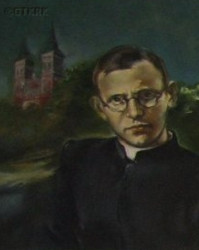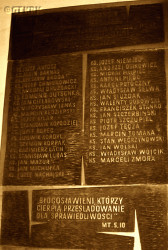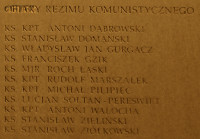Roman Catholic
St Sigismund parish
05-507 Słomczyn
85 Wiślana Str.
Konstancin deanery
Warsaw archdiocese, Poland
full list:
displayClick to display full list

searchClick to search full list by categories
wyświetlKliknij by wyświetlić pełną listę po polsku

szukajKliknij by przeszukać listę wg kategorii po polsku

Martyrology of the clergy — Poland
XX century (1914 – 1989)
personal data
surname
PILIPIEC
forename(s)
Michael (pl. Michał)
function
diocesan priest
creed
Latin (Roman Catholic) Church RCmore on
en.wikipedia.org
[access: 2014.09.21]
diocese / province
Przemyśl diocesemore on
www.przemyska.pl
[access: 2013.02.15]
RC Military Ordinariate of Polandmore on
en.wikipedia.org
[access: 2014.12.20]
honorary titles
„Polonia Restituta” Cross — 2nd Class, Commander's with Starmore on
„Polonia Restituta” Cross – 2nd_Class, Commander's with Star
(20.08.2009)
date and place
of death
08.12.1944

Głogowski foresttoday: Głogów Małopolski gm., Rzeszów pov., Lesser Poland voiv., Poland
more on
en.wikipedia.org
[access: 2010.08.11]
details of death
After German and Russian invasion of Poland in 09.1939 and start of the World War II, during German occupation, chaplain of the underground Armed Struggle Union ZWZ, in 1942 transformed into the Home Army AK (part of Polish Clandestine State), of Rzeszów region, among others, under nom‐de‐querre „Ski” and „John”.
Issued new, false birth certificates to people wanted and persecuted by the Germans.
Lecturer and teacher at Polish clandestine educational system at high school level (part of Polish Clandestine State).
Creator of „Polish soldier — insurgent prayer book”.
In the spring of 1944, promoted to the rank of captain of AK.
After German expulsion and Russian arrival in 1944 went into hiding.
On 03.12.1944, when returned to his parish in Błażowa to conduct morning Holy Mass ('roraty'), arrested by the Polish unit of Russian NKVD.
Jailed in Rzeszów Castle prison.
Tortured by Russian controlled Commie‐Nazi secret services UB. „He was terribly massacred. His cassock was cracked in many places. He had many wounds on his body. Blood sipped from the cracks on the skin. He was blowing in pain. It had to be terrible pain, since the priest could not stop slying and moaning. In the sounds of suffering, there however was no complaint, there was nothing of a cry for vengeance to the heavens, but there was something close to Christ's obedience, to the prayer «Thy will be done», there was a request for forgiveness in them”. Was supposed to answer his interrogators: „I am a servant and soldier of Jesus Christ, and at the same time of our homeland Poland, therefore I fought, I am fighting and I will continue to fight not only for the dignity of God and the Church of Christ, but also against the godlessness spread by you communists”.
Groundlessly accused of hiding clandestine printing press and radio, of organizing the attack on Hyżne UB post.
Murdered together with 3 other prisoners with a shot to the back of the head.
Body, covered with roofing felt, was set alight.
cause of death
mass murder
perpetrators
Russians / Poles
sites and events
RzeszówClick to display the description, GeneralgouvernementClick to display the description, Ribbentrop‐MolotovClick to display the description, Pius XI's encyclicalsClick to display the description
date and place
of birth
28.11.1912

Tarnawcetoday: Krasiczyn gm., Przemyśl pov., Subcarpathia voiv., Poland
more on
en.wikipedia.org
[access: 2021.10.09]
parents
PILIPIEC Basil
🞲 ?, ? — 🕆 ?, ?

Anne
🞲 ?, ? — 🕆 ?, ?
presbyter (holy orders)
ordination
21.06.1936

Przemyśltoday: Przemyśl city pov., Subcarpathia voiv., Poland
more on
en.wikipedia.org
[access: 2021.04.01]
Assumption of the Blessed Virgin Mary and St John the Baptist RC cathedral churchmore on
en.wikipedia.org
[access: 2025.03.14]
positions held
1939 – 1944
vicar — Błażowatoday: Błażowa gm., Rzeszów pov., Subcarpathia voiv., Poland
more on
en.wikipedia.org
[access: 2021.05.06] ⋄ St Martin the Bishop and Confessor RC parish ⋄ Tyczyntoday: Tyczyn gm., Rzeszów pov., Subcarpathia voiv., Poland
more on
en.wikipedia.org
[access: 2021.05.06] RC deanery — also: after the beginning of the Russian occupation, prefect and Latin teacher at the newly opened private grammar school
1938 – 1939
vicar — Futomatoday: Błażowa gm., Rzeszów pov., Subcarpathia voiv., Poland
more on
en.wikipedia.org
[access: 2021.10.09] ⋄ St Leonard the Confessor, St Michael the Archangel, St Adalbert the Bishop and Martyr and St Valentine the Martyr RC parish ⋄ Dynówtoday: Dynów urban gm., Rzeszów pov., Subcarpathia voiv., Poland
more on
en.wikipedia.org
[access: 2021.10.09] RC deanery
1936 – 1938
vicar — Pniówtoday: Radomyśl nad Sanem gm., Stalowa Wola pov., Subcarpathia voiv., Poland
more on
en.wikipedia.org
[access: 2021.10.09] ⋄ St Sigismund RC parish ⋄ Rozwadówtoday: district of Stalowej Woli, Stalowa Wola urban gm., Stalowa Wola pov., Subcarpathia voiv., Poland
more on
en.wikipedia.org
[access: 2021.10.09] RC deanery
1931 – 1936
student — Przemyśltoday: Przemyśl city pov., Subcarpathia voiv., Poland
more on
en.wikipedia.org
[access: 2021.04.01] ⋄ philosophy and theology, Theological Seminary
sites and events
descriptions
Rzeszów: During German occupation penal prison run by the Germans set up in Rzeszów Castle. At any one time more than 2,500 prisoners were held there (for instance from 01.04.1943 till 01.03.1944), mainly Poles. In the Castle basements and on prison yard executions were carried out of those sentenced by the German Sondergericht (Eng. special court) kangaroo court — other prisoners of the Castle were executed by the Germans at other sites in Rzeszów as well. After German withdrawal on 02.08.1944 and capture of Rzeszów by the Russians the prison was taken over initially by the Russian genocidal NKVD and then by Polish UB, a unit of murderous Russian NKVD. Thousands, of prisoners — Polish political activists and partisans, members of various clandestine organizations (among others from Home Army AK, part of Polish Clandestine State, and Freedom and Independence WiN) — were then held captive there. Local AK leader, Col. Lukas Ciepliński, future chairman of 4th Command of WiN, murdered by Commie‐Nazis in 1951, reported in 1944 that „during interrogations even women are brutally beaten. The processes […] are led by NKVD” and „the prisoners’ situation […] is dreadful. They simply perish from hunger. The food in German times compared to today was simply a luxury”. Executions of those held — Polish independence activists, but also German war criminals and Ukrainian nationalist — were also, as done by the Germans, carried out then in the Castle, in Castle’s basements and on the gallows in the prison yard. (more on: www.sw.gov.plClick to attempt to display webpage
[access: 2013.12.04])
Generalgouvernement: After the Polish defeat in the 09.1939 campaign, which was the result of the Ribbentrop‐Molotov Pact and constituted the first stage of World War II, and the beginning of German occupation in part of Poland (in the other, eastern part of Poland, the Russian occupation began), the Germans divided the occupied Polish territory into five main regions. In two of them new German provinces were created, two other were incorporated into other provinces. However, the fifth part was treated separately, and in a political sense it was supposed to recreate the German idea from 1915 (during World War I, after the defeat of the Russians in the Battle of Gorlice in 05.1915) of creating a Polish enclave within Germany. Illegal in the sense of international law, i.e. Hague Convention, and public law, managed by the Germans according to separate laws — especially established for the Polish Germ. Untermenschen (Eng. subhumans) — till the Russian offensive in 1945 it constituted part of the Germ. Großdeutschland (Eng. Greater Germany). Till 31.07.1940 formally called Germ. Generalgouvernement für die besetzten polnischen Gebiete (Eng. General Government for the occupied Polish lands) — later simply Germ. Generalgouvernement (Eng. General Governorate), as in the years 1915‐1918. From 07.1941, i.e. after the German attack on 22.06.1941 against the erstwhile ally, the Russians, it also included the Galicia district, i.e. the Polish pre‐war south‐eastern voivodeships. A special criminal law was enacted and applied to Poles and Jews, allowing for the arbitrary administration of the death penalty regardless of the age of the „perpetrator”, and sanctioning the use of collective responsibility. After the end of the military conflict of the World War UU, the government of the Germ. Generalgouvernement was recognized as a criminal organization, and its leader, governor Hans Frank, guilty of war crimes and crimes against humanity and executed. (more on: en.wikipedia.orgClick to attempt to display webpage
[access: 2024.12.13])
Ribbentrop‐Molotov: Genocidal Russian‐German alliance pact between Russian leader Joseph Stalin and German leader Adolf Hitler signed on 23.08.1939 in Moscow by respective foreign ministers, Mr. Vyacheslav Molotov for Russia and Joachim von Ribbentrop for Germany. The pact sanctioned and was the direct cause of joint Russian and German invasion of Poland and the outbreak of the World War II in 09.1939. In a political sense, the pact was an attempt to restore the status quo ante before 1914, with one exception, namely the „commercial” exchange of the so‐called „Kingdom of Poland”, which in 1914 was part of the Russian Empire, fore Eastern Galicia (today's western Ukraine), in 1914 belonging to the Austro‐Hungarian Empire. Galicia, including Lviv, was to be taken over by the Russians, the „Kingdom of Poland” — under the name of the General Governorate — Germany. The resultant „war was one of the greatest calamities and dramas of humanity in history, for two atheistic and anti‐Christian ideologies — national and international socialism — rejected God and His fifth Decalogue commandment: Thou shall not kill!” (Abp Stanislav Gądecki, 01.09.2019). The decisions taken — backed up by the betrayal of the formal allies of Poland, France and Germany, which on 12.09.1939, at a joint conference in Abbeville, decided not to provide aid to attacked Poland and not to take military action against Germany (a clear breach of treaty obligations with Poland) — were on 28.09.1939 slightly altered and made more precise when a treaty on „German‐Russian boundaries and friendship” was agreed by the same murderous signatories. One of its findings was establishment of spheres of influence in Central and Eastern Europe and in consequence IV partition of Poland. In one of its secret annexes agreed, that: „the Signatories will not tolerate on its respective territories any Polish propaganda that affects the territory of the other Side. On their respective territories they will suppress all such propaganda and inform each other of the measures taken to accomplish it”. The agreements resulted in a series of meeting between two genocidal organization representing both sides — German Gestapo and Russian NKVD when coordination of efforts to exterminate Polish intelligentsia and Polish leading classes (in Germany called «Intelligenzaktion», in Russia took the form of Katyń massacres) where discussed. Resulted in deaths of hundreds of thousands of Polish intelligentsia, including thousands of priests presented here, and tens of millions of ordinary people,. The results of this Russian‐German pact lasted till 1989 and are still in evidence even today. (more on: en.wikipedia.orgClick to attempt to display webpage
[access: 2015.09.30])
Pius XI's encyclicals: Facing the creation of two totalitarian systems in Europe, which seemed to compete with each other, though there were more similarities than contradictions between them, Pope Pius XI issued in 03.1937 (within 5 days) two encyclicals. In the „Mit brennender Sorge” (Eng. „With Burning Concern”) published on 14.03.1938, condemned the national socialism prevailing in Germany. The Pope wrote: „Whoever, following the old Germanic‐pre‐Christian beliefs, puts various impersonal fate in the place of a personal God, denies the wisdom of God and Providence […], whoever exalts earthly values: race or nation, or state, or state system, representatives of state power or other fundamental values of human society, […] and makes them the highest standard of all values, including religious ones, and idolizes them, this one […] is far from true faith in God and from a worldview corresponding to such faith”. On 19.03.1937, published „Divini Redemptoris” (Eng. „Divine Redeemer”), in which criticized Russian communism, dialectical materialism and the class struggle theory. The Pope wrote: „Communism deprives man of freedom, and therefore the spiritual basis of all life norms. It deprives the human person of all his dignity and any moral support with which he could resist the onslaught of blind passions […] This is the new gospel that Bolshevik and godless communism preaches as a message of salvation and redemption of humanity”… Pius XI demanded that the established human law be subjected to the natural law of God , recommended the implementation of the ideal of a Christian state and society, and called on Catholics to resist. Two years later, National Socialist Germany and Communist Russia came together and started World War II. (more on: www.vatican.vaClick to attempt to display webpage
[access: 2023.05.28], www.vatican.vaClick to attempt to display webpage
[access: 2023.05.28])
sources
personal:
bezdekretu.blogspot.comClick to attempt to display webpage
[access: 2013.02.15], pl.wikipedia.orgClick to attempt to display webpage
[access: 2013.01.17], www.katolicy.euClick to attempt to display webpage
[access: 2021.12.19], katolicy.euClick to attempt to display webpage
[access: 2013.01.17]
bibliographical:
„Register of Latin rite Lviv metropolis clergy’s losses in 1939‐45”, Józef Krętosz, Maria Pawłowiczowa, editors, Opole, 2005
„Biographical lexicon of Lviv Roman Catholic Metropoly clergy victims of the II World War 1939‐1945”, Mary Pawłowiczowa (ed.), Fr Joseph Krętosz (ed.), Holy Cross Publishing, Opole, 2007
„Schematismus Venerabilis Cleri Dioecesis PremisliensisClick to display source page”, Przemyśl diocesa Curia, from 1866 to 1938
original images:
kurierblazowskii.w.interiowo.plClick to attempt to display webpage
[access: 2017.03.24], mtrojnar.rzeszow.opoka.org.plClick to attempt to display webpage
[access: 2017.03.24], przemyska.plClick to attempt to display webpage
[access: 2017.03.24], niedziela.plClick to attempt to display webpage
[access: 2017.03.24], mtrojnar.rzeszow.opoka.org.plClick to attempt to display webpage
[access: 2017.03.24], mtrojnar.rzeszow.opoka.org.plClick to attempt to display webpage
[access: 2017.03.24], przemyska.plClick to attempt to display webpage
[access: 2017.03.24], przemyska.plClick to attempt to display webpage
[access: 2017.03.24], www.miejscapamiecinarodowej.plClick to attempt to display webpage
[access: 2014.08.14]
LETTER to CUSTODIAN/ADMINISTRATOR
If you have an Email client on your communicator/computer — such as Mozilla Thunderbird, Windows Mail or Microsoft Outlook, described at WikipediaPatrz:
en.wikipedia.org, among others — try the link below, please:
LETTER to CUSTODIAN/ADMINISTRATORClick and try to call your own Email client
If however you do not run such a client or the above link is not active please send an email to the Custodian/Administrator using your account — in your customary email/correspondence engine — at the following address:

giving the following as the subject:
MARTYROLOGY: PILIPIEC Michael
To return to the biography press below:
 Click to return to biography
Click to return to biography








